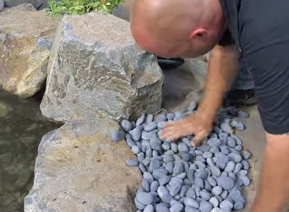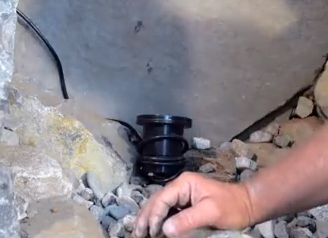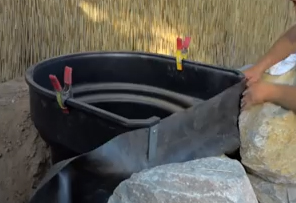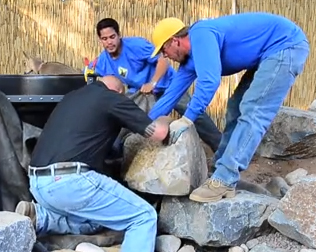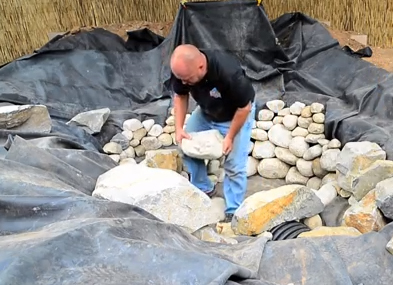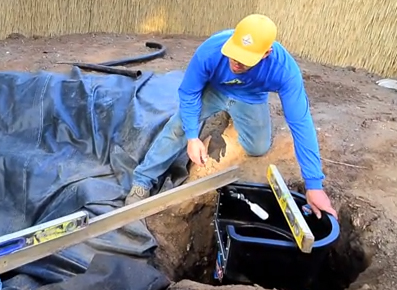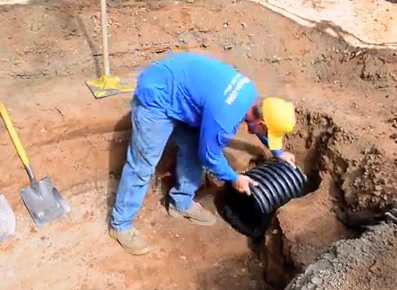pond design
As I mention at the start of this video, setting the edges is just about my favorite part of the pond-installation process. As is true with juggling and placing big rocks, there's an art to getting things just right and making the setting look as natural as possible - that is, as though the pond not only belongs there but has also been there for uncounted years.. As the video discusses, there are
Of all the messages I've tried to convey in this video series and its introductory texts, one of the crucial ones is my observation that the people who buy and own ponds will spend lots of time enjoying their watershapes after it gets dark. The only way to make that happen, of course, is to include an effective in-pond lighting system to make the watershape's best features
Earlier in this sequence of articles and videos, I mentioned how much I enjoy the fact that pond installation is an improvisational art form: You can roll through a design in your head and sketch it until your pencils are worn to nubs, but the reality is that working with boulders is a process of placement and on-site adjustment that ultimately brings a design vision to life. That's particularly true with waterfalls, which is why this single part of the series encompasses four videos and nearly 40 minutes of running time. And as you will notice, there are probably more
I've often seen rock placement described as an "improvisational art" by others who've written for WaterShapes, and I couldn't agree more. Once the liner's in place and it's time to dress it up with everything from large boulders to tiny gravel, I get the sense that this is less a construction task than it is an exercise in creative manipulation. You'll see some of that creativity on display in the two videos linked below, but what you'll also see is that experience really does count: In setting rocks in place, you end up handling and rotating and flipping and fine-tuning the positioning of dozens or hundreds or even
I've often seen rock placement described as an "improvisational art" by others who've written for WaterShapes, and I couldn't agree more. Once the liner's in place and it's time to dress it up with everything from large boulders to tiny gravel, I get the sense that this is less a construction task than it is an exercise in creative manipulation. You'll see some of that creativity on display in the two videos linked below, but what you'll also see is that experience really does count: In setting rocks in place, you end up handling and rotating and flipping and fine-tuning the positioning of dozens or hundreds or even
The task highlighted in the video linked below - that is, the process of setting and leveling the skimmer - is right up there at the top of the list when it comes to determining the success or failure of a pond-installation project. In fact, it may be the most important of all with respect to aesthetics, because it's what sets the pond's water level and has a huge amount to do with how things will look to people who approach the water's edge. We don't do the digging for this part of the installation until
The task highlighted in the video linked below - that is, the process of setting and leveling the skimmer - is right up there at the top of the list when it comes to determining the success or failure of a pond-installation project. In fact, it may be the most important of all with respect to aesthetics, because it's what sets the pond's water level and has a huge amount to do with how things will look to people who approach the water's edge. We don't do the digging for this part of the installation until
The task highlighted in the video linked below - that is, the process of setting and leveling the skimmer - is right up there at the top of the list when it comes to determining the success or failure of a pond-installation project. In fact, it may be the most important of all with respect to aesthetics, because it's what sets the pond's water level and has a huge amount to do with how things will look to people who approach the water's edge. We don't do the digging for this part of the installation until
One of the requirements of pond ownership is a willingness to see to the safety of the pond's inhabitants - especially the fish, which can represent a substantial investment in any pond, no matter its size. That's why, in every project we install, we include an appropriately sized fish cave (or two or three): These give the pond's residents places to hide in the event a predator appears at the water's edge or lands on the water's surface. It doesn't take much to provide one: just a big piece of drainage pipe will do the trick. They key is thinking about these features from the planning stage forward: There are few miseries with pond installation that are as gruesome as










